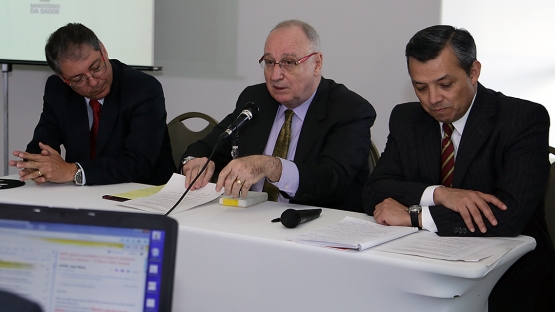Brasilia – The IAEA will facilitate the transfer of a gamma cell irradiator to Brazil to help the country’s battle with the Zika virus, the Agency announced at an expert meeting in Brasilia today. It could, in a few months, help scale up the production of sterile male mosquitoes to be released in selected areas of the country mostly affected by the current Zika virus outbreaks.
The equipment, a cobalt-60 gamma cell irradiator, is expected to be transferred to the Brazilian non-profit Sterile Insect Technique (SIT) centre Moscamed in Juazeiro, Bahia. The machine is an essential component in the use of SIT, a form of pest control that uses ionizing radiation to sterilize male insects mass-produced in special facilities. Once released, these males mate with wild females who do not produce any offspring, effectively suppressing the insect population over time. Read more about the potential use of the technique to control the Aedes aegypti mosquitoes that carry the Zika virus here.
“Moscamed has long experience in applying SIT to fight insect pests, and was one of the first facilities to mass rear sterilized mosquitoes in the world,” said Moscamed Director Jair Virginio. “The irradiator would allow our facility to produce up to 12 million sterilized male Aedes aegypti mosquitoes per week, reaching up to 750 000 people in 15 municipalities in the Brazilian states of Bahia and Pernambuco, which have been particularly hard-hit by Zika.”
The announcement was made as international experts from 12 countries gathered in Brasilia for a two-day meeting to share experiences on the use of SIT as part of a comprehensive approach to control mosquito populations along with other methods, such as site inspections and fumigation.
The meeting, organized in cooperation with Brazilian Ministry of Health, is part of the IAEA’s response to the current Zika outbreak in Central and South America. The World Health Organization declared Zika an international public health emergency earlier this month.
"Our discussion summarized the current status of all methods that can be used to fight disease-transmitting mosquitoes, and the recommendations in our report will be fed into a meeting starting tomorrow on the potential use of mosquito SIT in the region,” said Marc Vreysen, Head of the Insect Pest Control Laboratory at the Joint FAO/IAEA Division of Nuclear Techniques in Food and Agriculture.
Experts at the meeting agreed that SIT was an efficient, safe, environmentally neutral and sustainable method to control mosquito populations and fight vector-borne diseases like Zika and dengue fever.
“In the past we had effective tools to fight mosquitoes: we had the chemical insecticide DDT, and now the biological larvicide BTI, which is quite effective and safe,” said Jan O. Lundstrom, Mosquito Control Director at Swedish Biological Mosquito Control/NEDAB and President of the European Mosquito Control Association. “However, spraying alone cannot reach the mosquito larvae lurking in small, hidden, indoor water containers. This new use of SIT against mosquitoes addresses this problem, since the sterile male will seek and mate with the last female, so this approach is very promising for the future.”
SIT has been successfully used throughout the world for over 50 years for various agricultural and livestock insect pests.
Participants, including representatives from the Brazilian Ministry of Health and from the Pan-American Health Organization, also looked at options for using existing infrastructure to apply the technique beyond Latin America in the coming months.
The IAEA, through its technical cooperation mechanism, earlier this month donated special equipment to help Latin American and Caribbean countries detect the virus quickly, and is also preparing a project for approval at its March 2016 Board of Governors to help the region explore the use of SIT to control mosquito populations.
Spraying alone cannot reach the mosquito larvae lurking in small, hidden, indoor water containers. This new use of SIT against mosquitoes addresses this problem.




